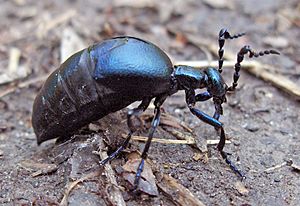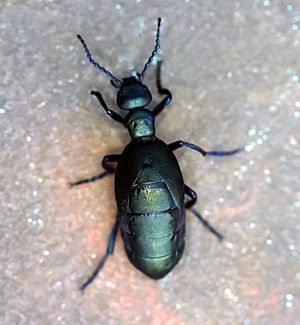Meloe facts for kids
Quick facts for kids Meloe |
|
|---|---|
 |
|
| Meloe violaceus | |
| Scientific classification |
|
| Kingdom: | Animalia |
| Phylum: | Arthropoda |
| Class: | Insecta |
| Order: | Coleoptera |
| Family: | Meloidae |
| Subfamily: | Meloinae |
| Genus: | Meloe Linnaeus, 1758 |
| Species | |
|
See text |
|
Meloe is a genus of blister beetles commonly referred to as oil beetles. The name derives from their defensive strategy: when threatened by collectors or predators they release oily droplets of hemolymph from their joints (legs, neck, and antennae). This fluid is bright orange and contains cantharidin, a poisonous chemical compound. Wiping the chemical on skin can cause blistering and painful swelling of the skin. This defensive strategy is not exclusive to this genus; all meloids possess and exude cantharidin upon threat.
Contents
Morphology
Members of this genus typically have shortened elytra and lack functional wings. They are often iridescent blue, green, or black with pits/punctures on the elytra and thorax, and a bloated abdomen. Male antennae have kinks in some species which are shaped differently in different species.
Biology
As with all other members of Meloidae, the larval cycle is hypermetamorphic; the larva goes through several body types, the first of which is typically a mobile triungulin that finds and attaches to a host in order to gain access to the host's offspring. They usually climb onto a flower head, and await a bee there. They will then attach themselves to the bee. If it is a male, they wait for mating with a female. They will switch to the female when this takes place. If the bee is a female, however, she will take them back to her nest unwittingly. Once in the nest, the larvae morphs into a grub-like "couch potato" and feeds upon all of the provisions and the larva. Next, they form a pupa and emerge in various seasons depending on the species. Each species of Meloe may attack only a single species or genus of bees. Some are generalists. Though sometimes considered parasitoids, it appears that in general, the Meloe larva consumes the bee larva along with its provisions, and can often survive on the provisions alone; thus they do not truly qualify for this designation (see Parasitoid for definition).
Upon surfacing from their underground lives as larvae, the adults feed on plants in the Ranunculaceae, Ipomoaceae, and Solanaceae families. Meloe have appetites which are virtually insatiable.
Mating begins when a male mounts a female and releases chemical components through the kinks on the antennae, massaging her antennae and pulling them back. This serves to calm the female. Mating then occurs, with the male transferring his cantharidin to the female during this period and she coats her eggs with it.
Species
Arranged alphabetically.
- Meloe afer Bland, 1864
- Meloe ajax Pinto, 1998
- Meloe aleuticus Borchmann, 1942
- Meloe americanus Leach, 1815
- Meloe angusticollis Say, 1824 – short-winged blister beetle
- Meloe barbarus LeConte, 1861
- Meloe bitoricollis Pinto and Selander, 1970
- Meloe brevicollis Panzer, 1793 – short-necked oil beetle
- Meloe californicus Van Dyke, 1928
- Meloe campanicollis Pinto and Selander, 1970
- Meloe carbonaceus LeConte, 1866
- Meloe chinensis Pan & Bologna, 2021
- Meloe dianella Pinto and Selander, 1970
- Meloe distincticornis Pan & Bologna, 2021
- Meloe dugesi Champion, 1891
- Meloe exiguus Pinto and Selander, 1970
- Meloe franciscanus Van Dyke, 1928
- Meloe gracilicornis Champion, 1891
- Meloe himalayensis Pan & Bologna, 2021
- Meloe impressus Kirby, 1837
- Meloe kashmirensis Pan & Bologna, 2021
- Meloe kaszabi Pan & Bologna, 2021
- Meloe laevis Leach, 1815 – oil beetle
- Meloe mediterraneus G. Muller, 1925 - mediterranean oil beetle
- Meloe lateantennatus Pan & Bologna, 2021
- Meloe nebulosus Champion, 1891
- Meloe niger Kirby, 1837
- Meloe occultus Pinto and Selander, 1970
- Meloe orientalis Pan & Bologna, 2021
- Meloe paropacus Dillon, 1952
- Meloe poggii Pan & Bologna, 2021
- Meloe proscarabaeus Linnaeus, 1758 - black oil beetle
- Meloe quadricollis Van Dyke, 1928
- Meloe rugosus Marsham, 1802 - rugged oil beetle
- Meloe shapovalovi Pan & Bologna, 2021
- Meloe strigulosus Mannerheim, 1852
- Meloe tropicus Motschulsky, 1856
- Meloe quadricollis Van Dyke, 1928
- Meloe vandykei Pinto and Selander, 1970
- Meloe variegatus Donovan, 1793
- Meloe violaceus Marsham, 1802 - violet oil beetle
- Meloe xuhaoi Pan & Bologna, 2021
See also
 In Spanish: Carralejas para niños
In Spanish: Carralejas para niños


